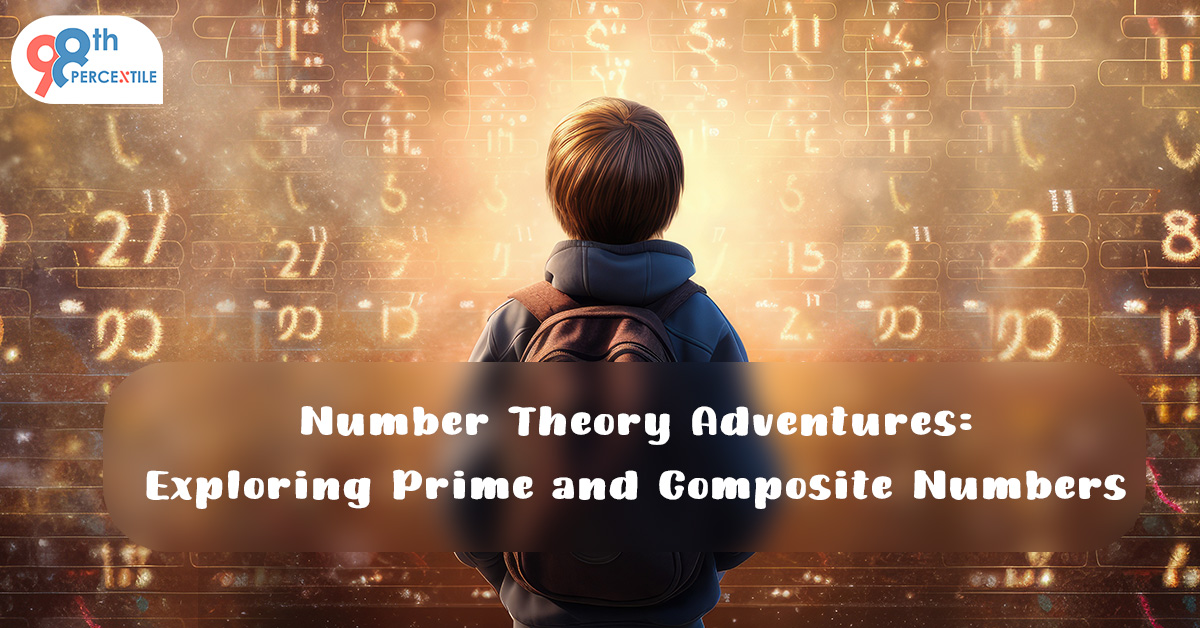INTRODUCTION:
In the vast landscape of mathematics, number theory stands as a captivating realm that has intrigued mathematicians for centuries. At its core, number theory deals with the properties and relationships of numbers, unraveling the mysteries embedded in the very fabric of arithmetic. Among the many facets of number theory, the exploration of prime and composite numbers emerges as a fascinating journey, revealing the beauty and intricacy woven into the seemingly simple realm of counting.

The Prime Puzzles
Let's embark on our number theory adventure by unraveling the enigma of prime numbers. Prime numbers, those elusive integers greater than 1 that have no divisors other than 1 and themselves, form the building blocks of the number system. Mathematicians have been captivated by the unique nature of primes for centuries, with their seemingly random distribution and infinite abundance.
Euclid, the ancient Greek mathematician, proved over two thousand years ago that there are infinitely many prime numbers. The proof is elegant in its simplicity, and it serves as a timeless reminder of the enduring mysteries that number theory holds. Despite this ancient knowledge, the distribution of primes remains one of the most profound and unsolved problems in mathematics—the famous Riemann Hypothesis continues to elude mathematicians, promising both challenge and reward to those who dare to venture into its complexities.
Composite Numbers: The Harmony of Factors
While prime numbers stand as the indivisible elements of the numerical landscape, their counterparts, the composite numbers, reveal a different kind of beauty. Composite numbers are integers greater than 1 that can be formed by multiplying two or more prime numbers together. In a sense, they represent the harmonious combination of primes, each composite number a unique symphony of its prime factors.
Exploring composite numbers provides insights into the concept of factorization, a fundamental mathematical operation with applications ranging from cryptography to data compression. The prime factorization of a composite number, the expression of the number as a product of its prime factors, unveils the mathematical DNA underlying its existence. This process is akin to breaking down complex molecules into simpler elements, revealing the hidden structure and connections within.
The Sieve of Eratosthenes: Unveiling Primes
To navigate the vast landscape of prime numbers, mathematicians have developed various tools, and among them, the Sieve of Eratosthenes stands as a timeless and efficient method. Named after the ancient Greek mathematician Eratosthenes of Cyrene, this sieve ingeniously identifies all prime numbers up to a given limit.
The Sieve of Eratosthenes operates on the principle of elimination. Starting with the list of numbers from 2 to the desired limit, the sieve systematically eliminates the multiples of each prime number, leaving behind only the primes. The simplicity of this method underscores the elegance that often characterizes mathematical solutions. Exploring the Sieve of Eratosthenes not only unveils the structure of primes but also provides a practical algorithm with applications in computer science and cryptography.
Applications in Cryptography: Prime Power
The adventures in number theory extend far beyond the realm of pure mathematics, finding practical applications in cryptography, the science of secure communication. One of the cornerstones of modern cryptography is the use of large prime numbers, particularly in asymmetric encryption algorithms.
In systems like RSA (Rivest–Shamir–Adleman), the security relies on the difficulty of factoring the product of two large prime numbers. The larger the prime numbers, the more challenging the task of factoring becomes, providing a robust foundation for secure communication in the digital age. Thus, the exploration of prime numbers transcends abstract mathematical concepts, shaping the landscape of secure information exchange.
The Goldbach Conjecture: The conjecture has been shown to hold for all integers less than 4×1018, but remains unproven despite considerable effort.
As we delve deeper into the world of number theory, the Goldbach Conjecture emerges as a tantalizing puzzle waiting to be solved. Proposed by the German mathematician Christian Goldbach in a letter to Euler in 1742, the conjecture posits that every even integer greater than 2 can be expressed as the sum of two prime numbers.
While the conjecture remains unproven, it has withstood centuries of mathematical scrutiny and computational verification for vast ranges of even numbers. The allure of Goldbach's Conjecture lies in its simplicity and universality. If proven true, it would provide a profound insight into the distribution of primes and the fundamental nature of even numbers.
CONCLUSION: A Mathematical Odyssey
In our number theory adventure, we have explored the captivating landscapes of prime and composite numbers, unveiling their unique properties, applications, and unsolved mysteries. From the ancient wisdom of Euclid to the modern applications in cryptography, the journey through number theory is a testament to the enduring allure of mathematical exploration.
As we navigate the prime puzzles, composite harmonies, and cryptographic applications, we are reminded that the beauty of mathematics lies not only in its abstract elegance but also in its tangible impact on the world. Whether securing digital communication or pondering the mysteries of prime distributions, the Odyssey through number theory is a testament to the enduring human quest for understanding the fundamental nature of numbers and the intricate patterns that weave the fabric of mathematics.
Related Articles:
1) Cybersecurity Challenges for Kids: Learning Online Safety
2) FINANCIAL LITERACY FOR KIDS: BUDGETING AND SAVING
3) Geometry Marvels in Math Kangaroo for Middle Schoolers
4) Minecraft Math: How Creativity Meets Learning

 Students/Staff
Students/Staff Parents
Parents ElevatEd
ElevatEd













